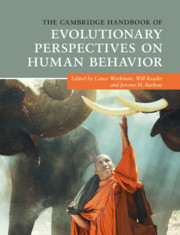Book contents
- The Cambridge Handbook of Evolutionary Perspectives on Human Behavior
- The Cambridge Handbook of Evolutionary Perspectives on Human Behavior
- Copyright page
- Dedication
- Contents
- Figures
- Tables
- Contributors
- Preface
- Acknowledgments
- Part I The Comparative Approach
- Part II Sociocultural Anthropology and Evolution
- Part III Evolution and Neuroscience
- Part IV Group Living
- Part V Evolution and Cognition
- Part VI Evolution and Development
- 21 Evolutionary Developmental Psychology
- 22 The Ontogeny and Evolution of Cooperation
- 23 Genomic Imprinting Is Critical for Understanding the Development and Adaptive Design of Psychological Mechanisms in Humans and Other Animals
- 24 Evolutionary Explanations for Bullying Behavior
- 25 Birth Order and Evolutionary Psychology
- Part VII Sexual Selection and Human Sex Differences
- Part VIII Abnormal Behavior and Evolutionary Psychopathology
- Part IX Applying Evolutionary Principles
- Part X Evolution and the Media
- Index
- References
23 - Genomic Imprinting Is Critical for Understanding the Development and Adaptive Design of Psychological Mechanisms in Humans and Other Animals
from Part VI - Evolution and Development
Published online by Cambridge University Press: 02 March 2020
- The Cambridge Handbook of Evolutionary Perspectives on Human Behavior
- The Cambridge Handbook of Evolutionary Perspectives on Human Behavior
- Copyright page
- Dedication
- Contents
- Figures
- Tables
- Contributors
- Preface
- Acknowledgments
- Part I The Comparative Approach
- Part II Sociocultural Anthropology and Evolution
- Part III Evolution and Neuroscience
- Part IV Group Living
- Part V Evolution and Cognition
- Part VI Evolution and Development
- 21 Evolutionary Developmental Psychology
- 22 The Ontogeny and Evolution of Cooperation
- 23 Genomic Imprinting Is Critical for Understanding the Development and Adaptive Design of Psychological Mechanisms in Humans and Other Animals
- 24 Evolutionary Explanations for Bullying Behavior
- 25 Birth Order and Evolutionary Psychology
- Part VII Sexual Selection and Human Sex Differences
- Part VIII Abnormal Behavior and Evolutionary Psychopathology
- Part IX Applying Evolutionary Principles
- Part X Evolution and the Media
- Index
- References
Summary
Genomic imprinting is genotype-independent parent-of-origin gene expression. It is a well-understood example of epigenetic inheritance, as the environment (i.e., whether a gene resided in the egg or sperm in the previous generation) leaves a reversible mark on offspring DNA. These marks are erased when the offspring produces its own gametes (i.e., sperm or egg), so that new parent-of-origin marks can be placed. The phenotypic effects of imprinted genes are significant, especially in terms of growth and neurobiology. Imprinted genes are rare in mammalian genomes, but here I make the case for the idea that they are critically important for our understanding of how natural selection shaped functional adaptations. There are approximately 100 imprinted genes in humans that have differentially methylated regions by parent of origin. The effects of imprinted genes are species, isoform (i.e., alternative transcripts), tissue, and developmentally dependent.
- Type
- Chapter
- Information
- Publisher: Cambridge University PressPrint publication year: 2020



